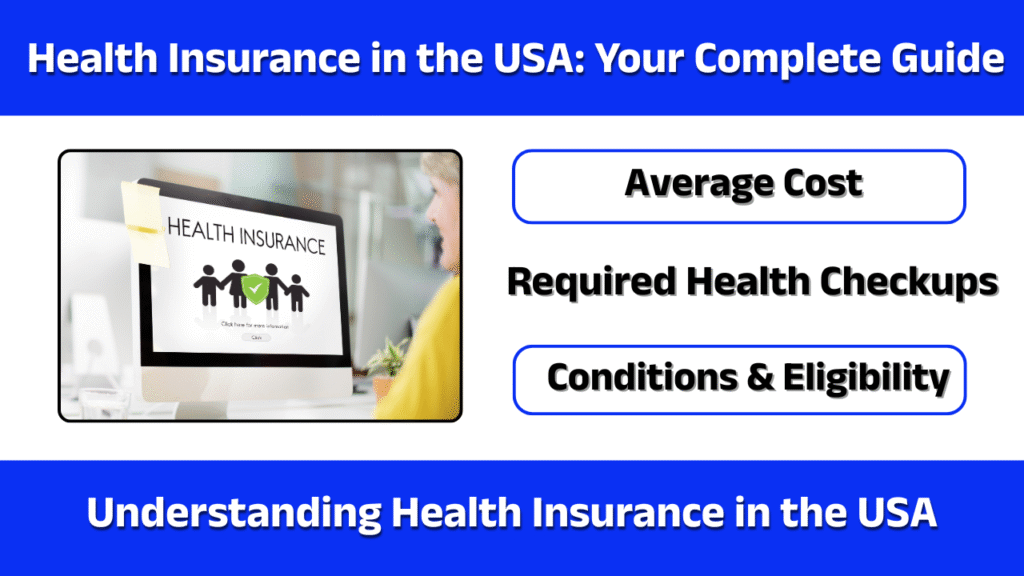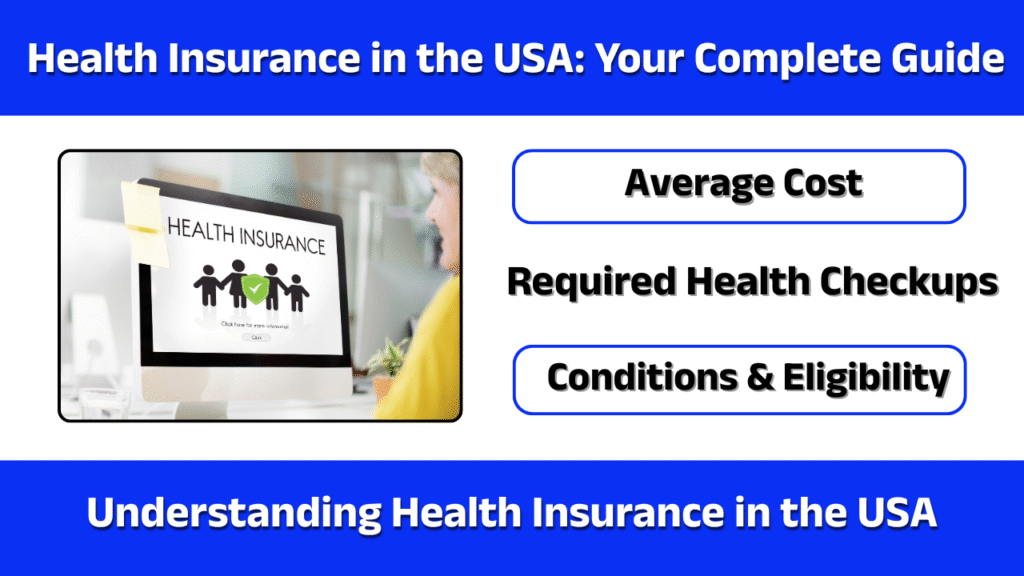Table of Contents
1.Health Insurance in the USA: Introduction
If there’s one thing most Americans can agree on, it’s that health insurance is complicated. And, let’s be honest, sometimes it feels like it’s designed to confuse us. Between premiums, deductibles, copays, networks, and a dozen plan types, it’s easy to feel lost. Yet, health insurance is more than just a bureaucratic maze—it’s a safety net, a financial shield, and often a pathway to regular, preventive care that keeps you healthy.
Whether you’re a young adult navigating your first job, a parent trying to cover your family, or someone approaching retirement, understanding your options is crucial. Without clarity, you might pay more than you need to or miss out on coverage that matters. In this guide, we’re going to break down health insurance in the U.S., explain how it works, give cost examples, and even highlight the recommended checkups that most plans cover. Think of this as your friendly, no-jargon roadmap to health insurance.
2. Types of Health Insurance in the usa
Health insurance in the U.S. comes in several flavors, and each has its own rules, benefits, and quirks. Let’s walk through the major categories:
A. Employer-Sponsored Insurance (ESI)
By far, the most common way Americans get coverage is through their employer. If your job offers health insurance, it usually means your company negotiates a plan with an insurance provider, then pays part of your monthly premium. You cover the rest.
How it works in real life: Imagine your company pays 70% of your health insurance premium, and you’re responsible for the remaining 30%. If your monthly premium is $600, you might only pay $180 out of your paycheck.
Pros: Health Insurance in the USA Often cheaper than individual plans, sometimes includes extra perks like dental or vision, and deductibles may be lower than other plan types.
Cons: You may lose coverage if you leave your job. Plans are limited to what your employer offers, so you can’t shop around much.

B. Individual / Marketplace Plans (ACA Plans)
If you don’t have insurance through work, the Affordable Care Act (ACA) Marketplace is your go-to. These plans are often called “exchange plans,” and they must cover essential benefits like doctor visits, hospital care, prescription drugs, maternity care, and preventive services.
Cost and subsidies: Prices vary based on your income and location. Luckily, the government provides subsidies that can lower monthly premiums dramatically. In some cases, people pay very little out of pocket.
Plan types you’ll encounter:
- Bronze: Low monthly premium, high deductible—good if you’re healthy and rarely see a doctor.
- Silver: Balanced option; eligible for additional cost-sharing reductions if you qualify.
- Gold & Platinum: Higher monthly premiums, but lower deductibles and out-of-pocket costs—better if you expect regular medical care.
C. Medicare
Medicare is federal health insurance primarily for people aged 65 and older. Younger people with certain disabilities can also qualify. Medicare has several parts:
- Part A: Hospital insurance
- Part B: Medical insurance (doctor visits, outpatient services)
- Part D: Prescription drug coverage
- Medicare Advantage (Part C): Offered by private companies; combines A, B, and often D into one plan
Example: A retired couple might have Medicare Part A covered automatically, pay around $164 per month for Part B, and then choose a Part D plan for prescriptions.
D. Medicaid
Medicaid is a state and federally funded program for people with low income, disabilities, or other qualifying conditions. Eligibility varies by state, and benefits can be broader than standard private insurance, including long-term care in some cases.
Quick story: Sarah, a single mother earning a modest income, can get her children covered under Medicaid or CHIP (Children’s Health Insurance Program) while also qualifying for subsidized marketplace coverage herself.
E. Short-Term and Other Private Plans
Short-term plans are typically cheaper but provide limited coverage and are not ACA-compliant. They’re sometimes used as a stopgap if you’re between jobs or waiting for other coverage.
Important note: These plans may not cover essential health benefits like maternity care, mental health services, or preventive screenings. So, they’re risky for long-term use.
3. Average Cost Overview
Health insurance isn’t cheap. Let’s break it down with real numbers, so you know what to expect:
Employer-Sponsored Plans (2025 Averages)
- Single coverage premium: ~$9,325 per year
- Family coverage premium: ~$26,993 per year
- Employee contribution (family plan): ~$6,850 annually
Out-of-pocket costs: Deductibles and copays vary. Typical deductibles for employer plans range from $1,000 to $2,500 for individual coverage, with family plans often higher. Copays might be $20–$40 for routine doctor visits.
Marketplace / Individual Plans
- Average monthly premium (silver plan): ~$477 (before subsidies)
- With subsidies: Can drop as low as $74 per month, depending on income
Deductibles and out-of-pocket maximums:
- Deductibles: $1,500–$5,000 per year for an individual
- Out-of-pocket maximum: Often $8,000–$10,000 for individuals, $16,000–$20,000 for families
Takeaway: Health insurance costs can be high, but subsidies, employer contributions, and careful plan selection can dramatically reduce what you actually pay.
4. Conditions & Eligibility
Different insurance types come with different rules. Here’s a quick guide:
Employer-Sponsored Insurance:
- Must be offered to full-time employees (usually 30+ hours/week)
- Coverage may extend to spouses and dependents, depending on plan
Marketplace / ACA Plans:
- Anyone who is a U.S. citizen or legal resident can apply
- Must not have access to affordable employer coverage or Medicaid
- Enrollment is generally during Open Enrollment (Nov–Jan), or during special life events like marriage or job loss
Medicare:
- Age 65+ automatically eligible
- Younger people with disabilities may qualify
- Must enroll in specific windows to avoid penalties
Medicaid / CHIP:
- Income-based eligibility, varies by state
- Some states expanded coverage to adults without children; others have stricter limits
Short-Term Plans:
- Usually available to adults under 65
- May exclude pre-existing conditions
Important note: Many plans require some paperwork or documentation to prove eligibility, so it’s worth checking early to avoid gaps in coverage.

5. Required Health Checkups
One of the biggest perks of health insurance is preventive care. Many plans, especially ACA-compliant ones, cover these services at no extra cost when done in-network.
Common recommended screenings and checkups:
- Annual wellness visit: General checkup to review health status
- Blood pressure checks: Usually yearly
- Cholesterol screenings: For adults starting at age 20, frequency depends on risk
- Diabetes screenings: For adults with risk factors
- Cancer screenings:
- Breast cancer: Mammograms starting at age 40–50
- Cervical cancer: Pap smears starting at age 21
- Colon cancer: Colonoscopy starting at age 45
- Immunizations: Flu shots, COVID-19 vaccines, tetanus boosters, etc.
- Pediatric checkups: Vaccinations, growth checks, developmental screenings for children
Example: John, a 45-year-old office worker, might schedule his annual physical, cholesterol check, and colon cancer screening—all covered without extra cost if he stays in-network.
6. Additional Key Information
Here are some helpful insights that make navigating U.S. health insurance easier:
A. What Affects Pricing
- Age: Older adults pay more
- Location: Some states or cities have higher healthcare costs
- Plan type: Bronze vs. Gold plans change premiums and out-of-pocket costs
- Tobacco use: Many plans charge extra
B. How Networks Work
- In-network providers: Cheaper, negotiated rates
- Out-of-network providers: Can be very expensive
- Tip: Always check your plan’s provider directory before scheduling visits
C. Common Mistakes to Avoid
- Choosing a plan based solely on the monthly premium
- Ignoring deductibles and out-of-pocket max
- Assuming all services are covered without checking in-network status
- Waiting until a medical emergency to understand your coverage
D. Useful Terms to Know
- Premium: What you pay every month for insurance
- Deductible: Amount you pay before insurance starts covering costs
- Copay: Fixed fee for visits or medications
- Coinsurance: Percentage of costs you share after deductible is met
- Out-of-pocket maximum: The cap on how much you pay in a year
7. Conclusion
Health insurance in the United States can feel overwhelming at first, but it doesn’t have to be scary. By understanding the different types—employer-sponsored plans, ACA marketplace plans, Medicare, Medicaid, and even short-term options—you can make informed choices that protect both your health and your wallet.
Remember: the monthly premium is just part of the story. Deductibles, copays, coinsurance, and network rules all matter. Take advantage of preventive care and recommended checkups—they’re covered in most plans and can prevent expensive medical emergencies down the line.
Finally, don’t rush. Compare plans, consider your own health needs, check eligibility carefully, and be mindful of the deadlines for enrollment. A little planning can save a lot of stress, money, and headaches. After all, health insurance isn’t just paperwork—it’s peace of mind for you and your family.
information on other topic: Why the Crypto Market Is Down $1.2 Trillion — And What Comes Next

